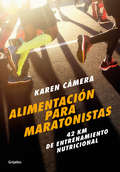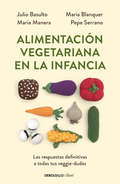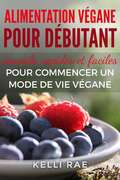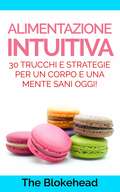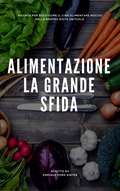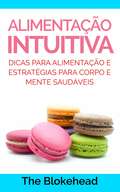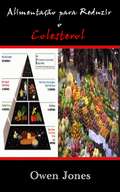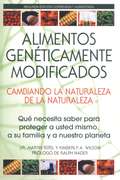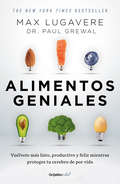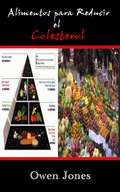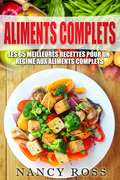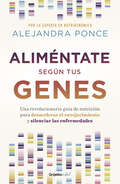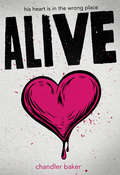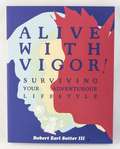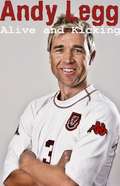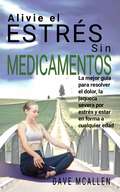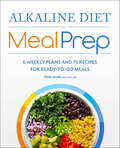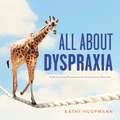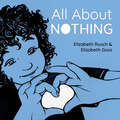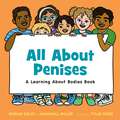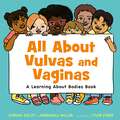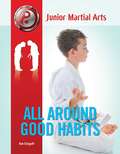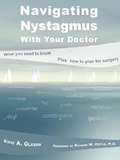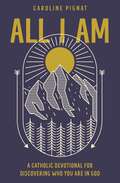- Table View
- List View
Alimentación para maratonistas: 42 km de entrenamiento nutricional
by Karen CameraUn libro muy práctico sobre nutrición deportiva para preparar, correr y recuperarse de un maratón, pero también una guía para aprender y entrenar la alimentación. Un maratón es más que una carrera. Es un desafío físico y mental, que requiere una preparación progresiva y adecuada, diferente a cualquier otra. La buena alimentación, la conciencia del propio cuerpo y el entrenamiento son fundamentales para asegurarte estar en una zona segura y saludable, y tener más posibilidades de alcanzar tu meta. Para eso, hay que entrenar, descansar, planificar las comidas y ver cómo reacciona tu organismo. Pensado para maratonistas y corredores en general, este nuevo libro de Karen Cámera -nutricionista experta en alimentación para deportistas- propone estrategias, consejos, recetas y mucha información para saber cómo preparar, correr y recuperarse de una carrera. Ingredientes saludables, nutrientes, buenos hábitos y un plan adecuado para el máximo rendimiento.
Alimentación vegetariana en la infancia: Las respuestas definitivas a todas tus veggie-dudas
by Julio Basulto Varios autores¿Qué es el vegetarianismo? ¿Y el veganismo? ¿Son opciones saludables? Y, de ser así, ¿lo son incluso para niñas y niños? Un libro de Julio Basulto, Maria Blanquer, Maria Manera y Pepe Serrano. Este es el manual definitivo para una alimentación saludable sin productos de origen animal en la infancia. Con un estilo directo y sencillo, sin perder nunca el rigor, Julio Basulto, Maria Blanquer, Maria Manera y Pepe Serrano responden a las dudas más habituales a las que personas adeptas, simpatizantes, escépticas y detractoras se enfrentan día a día. Asimismo, nos invitan a descubrir platos y trucos con los que aprender a cocinar sin carne ni pescado e incluso sin lácteos ni huevos. Y afrontan, a su vez, el que es quizá el mayor de los debates: la aplicación del vegetarianismo a cualquier edad. Escrito por cuatro grandes especialistas en nutrición y pediatría, este libro está destinado a convertirse en una guía de referencia sobre (o para) las dietas basadas en vegetales. «Cumplirá las expectativas de las familias que desean que sus hijos adopten una dieta vegetariana, pero también será de utilidad para las que inician el camino hacia una dieta basada en alimentos de origen vegetal y muy pocos de procedencia animal.» Del prólogo de Carlos Casabona Julio Basulto Marset es dietista-nutricionista y profesor asociado en el Grado de Nutrición Humana y Dietética de la Universidad de Vic. Es colaborador habitual en radio y prensa y autor de varios libros. Maria Blanquer Genovart ha trabajado como dietista-nutricionista así como en diversos centros médicos y de asesoramiento e investigación nutricional. Desde el 2009 trabaja en la Agència de Salut Pública de Catalunya. Maria Manera Bassols se diplomó en Nutrición Humana y Dietética y se especializó en Medicina Preventiva y Promoción de la Salud. Desarrolla gran parte de su actividad profesional en la Agència de Salut Pública de Catalunya y la docencia. Pepe Serrano Marchuet se dedica a la medicina desde hace más de veinticinco años. Es vocal de la Societat Catalana de Pediatria, miembro de la Asociación Española de Pediatría de Atención Primaria y referente del grupo Infancia y Dieta Mediterránea.
Alimentation végane pour débutant: conseils rapides et faciles pour commencer un mode de vie végane
by Julie Nantel Kelli RaeVous voulez adopter un mode de vie végane ? Alimentation végane pour débutant : conseils rapides et faciles pour commencer un mode de vie végane est pour les vrais débutants qui ne connaissent pas le mode de vie végane. Il y a tellement d'informations disponibles, alors où commencer ? Dans ce court livre, vous trouverez beaucoup de conseils qui vous conduiront vers le succès dans votre cheminement vers un mode de vie végane. J'ai également inclus quelques photos de mes repas. L'aspect mental du changement est ÉNORME, donc environ la moitié du livre porte sur la fondation d'un mental solide avant d'attaquer les repas. Vous voulez en apprendre plus ? Téléchargez votre copie dès maintenant ! Pour acheter, il suffit d'appuyer sur le bouton « Acheter » au haut de la page.
Alimentazione intuitiva: 30 trucchi e strategie per un corpo e una mente sani oggi!
by The BlokeheadGrazie per aver acquistato il libro "Alimentazione intuitiva". Questo libro contiene consigli efficaci e strategie che vi possono aiutare ad ottenere un corpo e una mente sani attraverso l'alimentazione intuitiva. Verrete a conoscenza degli errori comuni commessi dalle persone che ricorrono al rimpinzarsi quando sotto stress, lutto o annoiate. Imparerete di più sull'alimentazione emozionale. Leggerete anche del perché la dieta non vi aiuterà mai a perdere peso.
Alimentazione: la grande sfida.
by Enrique Pons Sintes Luca BianchiAlimenti tossici e nocivi nei supermercati, la grande sfida, alimentarsi in modo sano senza essere ingannati.
Alimentação Intuitiva: dicas para alimentação e estratégias para corpo e mente saudáveis
by The BlokeheadEsse livro traz dicas e estratégias eficazes que podem lhe ajudar a conseguir corpo e mente saudáveis por meio da alimentação intuitiva. Você vai aprender sobre os erros comuns das pessoas que acabam comendo demais sob muito estresse, tristeza ou tédio, você vai aprender sobre alimentação intuitiva, também vai ler sobre o motivo da dieta nunca ajudar a perder peso.
Alimentação para reduzir o colesterol (Como fazer... #23)
by Owen JonesAlimentação para reduzir o colesterol O colesterol é algo que muitas pessoas temem, mas que a maioria não entende. As pessoas temem ter «colesterol», mas elas não percebem que existem dois tipos de colesterol e que têm de ter algum de ambos os tipos. Os problemas surgem do facto de ter mais colesterol do que o necessário. Isto ocorre porque o colesterol é uma substância gordurosa que pode aderir às paredes das artérias, acumular-se e causar obstrução. Isto significa que o coração precisa de bombear com mais força para enviar oxigénio e nutrientes suficientes para onde eles são necessários. Isto provoca um aumento na pressão sanguínea, que frequentemente conduz a doenças cardíacas, o que, por sua vez, leva a ataques cardíacos e AVC. Felizmente, existem três maneiras de sair desta dificuldade: alimentação, exercícios e medicamentos. Como os medicamentos têm de ser tomados diariamente e durante o resto da vida, a maioria das pessoas prefere tentar reduzir os seus níveis de colesterol sem recorrer a eles. No entanto, isso significa mudanças no estilo de vida. Muitas pessoas tentaram fazer dieta para perder peso e fracassaram. A dieta para reduzir o colesterol não é exatamente a mesma coisa, mas há semelhanças e uma dieta de perda de peso pode facilmente ligar-se a uma dieta para reduzir o colesterol.
Alimentos Genéticamente Modificados: Qué necesita saber para proteger a usted mismo, a su familia y a nuestro planeta
by Ralph Nader Martin Teitel Kimberly A. WilsonThe book that exposes the threat to our food supply from genetic engineering • Is both an exposé and educational primer on this controversial technology that is already a part of every American’s diet • Explains the dangers of these foods to ourselves and our environment in easily understood terms • Includes a comprehensive guide to actions you can take to safeguard your food supply This book is both an exposé and educational primer on this controversial technology that is already a part of every American’s diet. Genetic engineering has far outrun the science that must be its first governing discipline. Corporate promoters, such as the Monsanto Corporation, are racing to be first in their markets, while playing a guessing game with the environment and their customers on farms and in grocery stores. This is why they cannot answer the many central questions raised in this book. As authors Martin Teitel and Kimberly Wilson point out, the very techniques used to change the genetic material in traditional food plants may change the function of other genes in ways that we cannot foresee. Costly mistakes of past and current technologies--from motor vehicles to atomic power reactors--should give us pause.
Alimentos geniales: Vuélvete más listo, productivo y feliz mientras proteges tu cerebro de por vida (Colección Vital #Volumen)
by Max LugavereUna revolucionaria estrategia destinada a llevar nuestra salud cognitiva hasta sus límites naturales. ¿Qué aspectos del entorno permiten que nuestro cerebro prospere en lugar de enfermar? Esta pregunta surgió en la mente del reconocido documentalista Max Lugavere luego de reconocer en su madre los primeros síntomas de una misteriosa forma de demencia. Una incógnita nacida de una dolorosa experiencia que, al transformarse en una búsqueda incansable de la verdad, lo llevó a reunir respuestas entre las investigaciones más innovadoras de la ciencia de la salud cerebral, y cuyos resultados cambiarán para siempre la manera en que concebimos nuestro órgano más delicado. No importa si fue el deseo de claridad mental, la incapacidad de lidiar con el estrés o la depresión, la inquietud ante el deterioro cognitivo de un ser querido o el temor de una predisposición genética a un destino similar lo que llevó Alimentos geniales a tus manos. Aquí descubrirás los mejores nutrientes para preservar tu memoria, rejuvenecer tu cerebro, mejorar tu concentración, tu capacidad creativa y mantener un estado mental equilibrado. Sólo así nos reencontraremos con esa versión energética, saludable y optimizada de nosotros mismos que tanto anhelamos.
Alimentos para Reducir el Colesterol: Cómo Usar los Alimentos para Reducir el Colesterol (Como hacer... #23)
by Owen JonesAlimentos para Reducir el Colesterol Cómo Usar los Alimentos para Reducir el Colesterol Hola y gracias por comprar mi libro electrónico llamado 'Alimentos Para Reducir el Colesterol'. Espero que encuentre aquí información útil, práctica y posiblemente rentable en el futuro. La información en este libro electrónico sobre el colesterol y temas relacionados se organiza en 17 capítulos de aproximadamente 500 a 600 palabras cada uno. Este es un manual integral de autoayuda y de cómo hacer, sobre 'Alimentos para reducir el colesterol'. El nivel elevado de colesterol es una de las causas más prolíficas de insalubridad en el mundo en este momento, y este manual debe tomarse como una idea de la posibilidad de corregir el problema a través de la dieta. Alimentos para el pensamiento, se podría decir :-) Le ayudará a establecer y controlar sus niveles de colesterol, e incluso puede ayudarlo a mantenerse alejado de los medicamentos. Como un bono adicional, le concedo permiso para usar el contenido en su propio sitio web o en sus propios blogs y boletines, aunque es mejor si los vuelve a escribir con sus propias palabras. También puede dividir el libro y revender los artículos. De hecho, el único derecho que no tiene es revender o regalar el libro tal como se le entregó.
Aliments complets: Les 65 meilleures recettes pour un régime aux aliments complets
by Nancy Ross Cecile SuneVoici un aperçu du genre de recettes aux aliments complets que vous allez découvrir... Petits déjeuners aux aliments complets Excellents casse-croûte et hors-d’œuvre pour la journée Déjeuners délicieux et équilibrés pour le bureau Dîners que toute la famille va adorer Quelque chose pour les amateurs de sucreries Et bien plus encore ! Voici un aperçu des recettes que vous allez apprendre... Bol petit déjeuner au quinoa Frittata de dinde Salade de riz complet aux crevettes Soupe mexicaine Côtes de porc et patates douces Poulet au curry et au miel Kebabs au poulet Lasagne végétarienne Pain de viande Poulet à l’orange Hachis parmentier Et bien plus encore !
Aliméntate según tus genes: Una revolucionaria guía de nutrición para desacelerar el envejecimiento y silenciar las enfermedades
by Alejandra PonceLa ciencia nos ha concedido la longevidad. ¿Cómo podemos disfrutar de ella? ¿Qué debemos hacer para gozar de una vejez saludable y libre de enfermedades? En este libro encontrarás las respuestas. No hay ningún plan de alimentación funcional para todo el mundo: lo que a unos les sienta bien, a otros puede hacerles daño. ¿Cómo se explica? Por el código genético, que es absolutamente único en cada persona. Alejandra Ponce, experta en nutrigenómica, una apasionante y pionera ciencia que une la genética y la nutrición, nos advierte que, contrario a lo que la medicina tradicional ha dictado, no es correcto seguir recomendaciones generales: hay que buscarun plan de alimentación adecuado para tus genes, de manera que goces hoy de una vida sana y que llegues a la vejez sin enfermedades. Aunque estamos programados genéticamente para presentar ciertos padecimientos, la combinación de una nutrición personalizada y un estilo de vida saludable hace posible retrasarlos o incluso silenciarlos para siempre. Este libro es una revolucionaria guía que te ayudará a convertir tu longevidad en años que se disfruten.
Alive
by Chandler BakerStella Cross's heart is poisoned. After years on the transplant waiting list, she's running out of hope that she'll ever see her eighteenth birthday. Then, miraculously, Stella receives the transplant she needs to survive. Determined to embrace everything she came so close to losing, Stella throws herself into her new life. But her recovery is marred with strange side effects: Nightmares. Hallucinations. A recurring pain that flares every day at the exact same moment. Then Stella meets Levi Zin, the new boy on everyone's radar at her Seattle prep school. Stella has never felt more drawn to anyone in her life, and soon she and Levi can barely stand to be apart. Stella is convinced that Levi is her soul mate. Why else would she literally ache for him when they are apart? After all, the heart never lies . . . does it?
Alive With Vigor!: Surviving Your Adventurous Lifestyle (Diy Ser.)
by Robert Earl Sutter IIIAlive With Vigor: Surviving Your Adventurous Lifestyle contains the stories of survival from a wide spectrum of contributors on all matters of preventative health care, the hard decisions we each have to make, Do It Yourself health care, and how to deal with extracting health care from government/corporate health care systems. Alive With Vigor! has a special focus on queer, youth, and transgendered people, recognizing different health care needs. Alive With Vigor! is a how to book where you can put the advice directly to use in your life!
Alive and Kicking
by Andy LeggIn 2005 Welsh soccer star Andy Legg's life was turned upside down. Forced to retire after finding out that a lump in his neck was cancer, it seemed that his 15-year career, which included playing for Cardiff and Swansea City, was over. But an operation to remove the tumour was successful and the 42-year-old Neath-born star is now back on the field. "Alive and Kicking" is his emotional account of his fears for his career and his life, and his gratitude for the support of his fans which give him the strength to fight on. About the Author Andy Legg is a Welsh international footballer and one of a select band to play for South Wales arch rivals Swansea City and Cardiff City.Signed by Swansea City in 1988, he turned professional at the age of 22. An aggressive left sided player, Andy made more than 160 League appearances for the Swans, before moving on to Notts County, Birmingham City, Ipswich and Reading. He joined Cardiff City in 1998. His League career totalled more than 600 appearances; he played six times for Wales and made the Guinness Book of Records for his long throw-in. He's coached at Peterborough, managed Hucknall Town and continues to play for Welsh Premier League side Llanelli.
Alivie el estrés sin medicamentos: La mejor guía para resolver el dolor, la jaqueca severa por estrés y estar en forma a cualquier edad
by Dave McAllenAlivie el Estrés sin Medicina es un libro sobre la lucha para redimir nuestra salud de nuestra estresante y agitada vida diaria. Dave McAllen trabajó con expertos en salud y bienestar y llega a los lectores con aparatos prácticos y probados para contrarrestar estos hábitos cotidianos poco saludables de nuestro mundo 24-7. Sus propias experiencias, así como las investigaciones sobre la vida ajetreada de otras condiciones de trabajo estresantes y de alto rendimiento, llevaron a McAllen a adaptar su guía y las herramientas que diseñó. Consideró a los hombres y mujeres de un amplio espectro de industrias y cómo pueden mantenerse sanos frente a las abrumadoras experiencias de trabajo. Ya sea un ama de casa a tiempo completo o los padres, un estudiante muy ocupado, un empresario, aquellos que quieren mantenerse en forma a partir de los cuarenta - Aliviar el estrés sin medicamentos es para todos los que llevan una vida ocupada y piensan que no pueden entrar en el camino de un estilo de vida saludable. La guía de McAllen también es ideal para las personas que temen que su valioso tiempo se vea invadido y que no les gustan las actividades dolorosas. También dice exactamente cómo manejar los desafíos específicos de la salud. De esta manera, ayuda a los lectores a superar el estrés, los renueva, dándoles la fuerza para superar el día siguiente y más allá.
Alkaline Diet Meal Prep: 6 Weekly Plans and 75 Recipes for Ready-to-Go Meals
by Terri WardStart the alkaline diet you'll actually stick to—with meal prep! An alkaline diet means eating wholesome and nutritious ingredients that are not acid-forming in order to balance your body chemistry and boost your health. But how do you know what foods to eat? And how do you make it convenient and sustainable to eat them every day? This simple guide breaks down how to prep your meals for 6 weeks so you always have healthy, homemade, alkalizing options ready to go.Get more than other meal prep cookbooks with:Alkaline eating basics—Get an introduction to the alkaline diet and learn how pre-planning your meals helps you save time and stay motivated.Plenty of options—Feel energized and satisfied with 75 recipes that taste great, are designed to be made in advance, and are easy enough for any home cook.Meal prep success—Each weekly meal plan includes a menu, a complete list of ingredients, and detailed instructions for cooking and prepping. You'll even find tips on how to store your meals and use your leftovers.Take the challenge out of the alkaline diet and commit to it for the long run.
All About Dyspraxia: Understanding Developmental Coordination Disorder
by Kathy HoopmannAll About Dyspraxia follows in the best-selling footsteps of Kathy Hoopmann's All Cats are on the Autism Spectrum and All Dogs have ADHD. Through engaging text and full-colour photographs, this book shows how people with dyspraxia see and experience the world and highlights the unique characteristics that make them special.A perfect introduction to dyspraxia for those recently diagnosed with the condition, as well as their families, friends, and the people who work with them. People with dyspraxia will also appreciate the book for the way it shares their perspectives on life with care and gentle humour.
All About Nothing (All About Noticing)
by Elizabeth RuschAn artful picture book exploration of negative space and the beauty of nothingness. This mindful meditation encourages children to see the world differently.Nothing is really something! What might be hidden in the space around things, and how is that space important? In art, this is known as negative space, but &“nothing&” can be thought of more broadly—as free time during the day or the space between people. When we allow ourselves a moment of nothingness, we make room for creativity and so much more.
All About Penises: A Learning About Bodies Book
by Dorian Solot Marshall MillerHead, shoulders, knees, and . . . penises! Young children are curious about all body parts.With bright illustrations, readable language, and a matter-of-fact tone, this guide offers readers the information they need to understand how bodies work.All About Penises is a book that embraces body diversity, reassures kids, and provides caregivers easy ways to answer the common questions that children have. Additional guidance for parents and caregivers includes more information on being an askable parent and how to talk to young children about sensitive topics.
All About Vulvas and Vaginas: A Learning About Bodies Book
by Dorian Solot Marshall Miller"Educational and approachable" – Publishers Weekly Head, shoulders, knees, and . . . vulvas and vaginas! Young children are curious about all body parts.With bright illustrations, readable language, and a matter-of-fact tone, this guide offers readers the information they need to understand how bodies work.All About Vulvas and Vaginas is a book that embraces body diversity, reassures kids, and provides caregivers easy ways to answer the common questions that children have.Additional guidance for parents and caregivers includes more information on being an askable parent and how to talk to young children about sensitive topics.
All Around Good Habits (Junior Martial Arts)
by Kim EtingoffMartial arts students don't just learn how to fight. They also learn lots of other important things they use every day. They learn good habits, like being on time, respecting other people, and taking care of their bodies. Discover how martial arts can help you form good habits too!
All Children Have Different Eyes: Learn to Play and Make Friends
by Edie Glaser Maria BurgioAll Children Have Different Eyes is the only picture book to model healthy social development of children with visual impairment while also helping children with normal vision become aware and tolerant of the limitations of kids who have low vision. Realistic characters who live with strabismus (crossed eyes), nystagmus (wobbly eyes), albinism, nearsightedness, cataract, red/green color deficiency, and other conditions confidently model how to: 1) Deal with bullies, 2) Handle mistakes responsibly, 3) Explain their condition, and 4) Take leadership roles. Engaging activities in the back of the book help parents and teachers reinforce the competencies modeled in the story. A free Teacher Guide for grades K-3 at www.lowvisionkids.com integrate the important lessons of the book with educational standards in Reading, Writing, Art and even Physical Education. With this training and awareness, all kids can learn to become better friends rather than exclusive and intolerant classmates and neighbors.
All Free
by Asma ElferkoussA shy person, a pervert or a victim, through the pages you will discover different universes and different perspectives moving through the letters of the universe, letters that you can easily identify with... Between feeling and appeasement, you will find yourself as you read... Sharing the common need of all of us to be free...
All I Am: A Catholic Devotional for Discovering Who You Are in God
by Caroline PignatThe teen years can be a confusing time of figuring out where you belong, who you are, what you can do, and who you can become, all while searching for a sense of safety as you engage with the world. In All I Am, these core needs of belonging, identity, ability, purpose, and security are explored through God&’s traits in the Bible, showing readers 13 and up that the great I AM not only meets our needs because of all the amazing things he is, but how we also embody those traits because we are his children.Inside the pages of All I Am are 90 devotions from a Catholic perspective that use conversational language to apply God&’s truth to your life through relatable examples and real-world applications, each helping you think, act, and be like Jesus and grow your faith and self-esteem.Content also includes:Scripture from the NRSV editionA two-color interior with an engaging design&“Digging Deeper&” and &“Rest and Remember&” features for deeper daily or weekly reflectionEncouraging quotes from saints, popes, and inspiring CatholicsOriginal and traditional Catholic prayers that help you easily connect with God every dayAll I Am is perfect for:Graduation gifts, Confirmation, and holiday presentsEncouraging teens in their faith journeyUse in spiritual development classes
